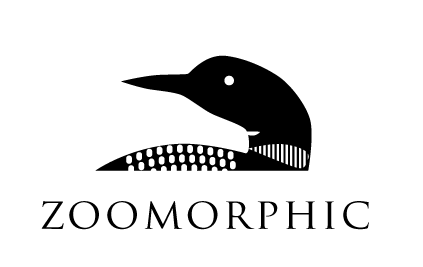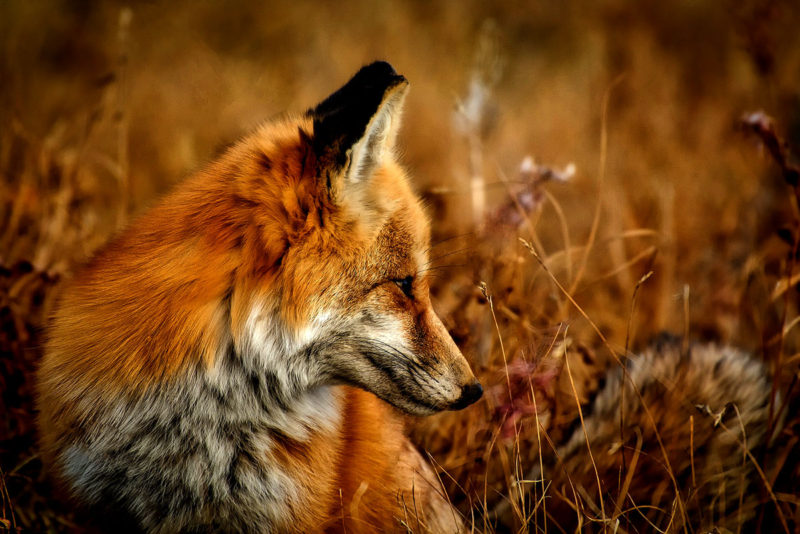by Alex Klaushofer
This story starts in suburban London. One dark night, I was walking home when I heard a rustling coming from a large pampas grass in a garden in the neighbouring street. It was such a pleasantly busy noise, so redolent of enthusiastic, purposeful activity, that my curiosity was piqued: who or what could it be? On impulse, I stopped and addressed the plant in the sweet tone usually reserved for children and pets. Out popped a fox cub, his face and ears cocked as he looked at me enquiringly. It seemed that he too was curious: he sat down on his haunches, his front paws drawn neatly together, and we both took a good long look at each other. Then he went back into the pampas grass and I went on home. But from that moment on, as far as foxes were concerned, I was a changed woman.
Up until then I had regarded foxes as a nuisance, a pest that threatened the hard work of reclaiming my newly-acquired garden from the bramble-ridden state into which it had fallen. I would plant some bulbs in the bare border to find that, overnight, the soil had been churned up and a little holloway tunnelled under the fence. Holes appeared in the delicate new grass, piles of poo in the middle of the lawn I was struggling to cultivate. I boarded up the tunnels, but more gaps appeared. The foxes’ main entry point was the corner farthest from the house which adjoined allotments and another semi-wild garden; the ground was littered with an ever-changing selection of scrabbled stones. So, having read that human smells were a good fox deterrent, I left an old T-shirt sprinkled with my pee wrapped around the tree in Fox Corner.
It made no difference: surrounded on three sides by green spaces connected to a patch of local woodland, my garden was an established thoroughfare for the local wildlife. One winter’s morning, I woke to find the ground covered in a blanket of snow. Its crystalline surface was broken only by an animal track that criss-crossed the garden in an organised fashion, covering the ground but never repeating the route. Something about the narrowness of the paw prints and the manner of their imprinting suggested both dexterity and speed, while the coverage indicated a thorough approach. I felt a thrill of urbanite fear: the prints came right up the dozen steps that ranup to the kitchen door. Something wild had tried to get into the flat while I slept.
I don’t remember the point at which I gave up trying to keep foxes out of the garden and adopted a policy of relaxed co-existence, cultivating the garden to accommodate both humans and animals. But I do remember the exact moment I first set eyes on Little Fox. It was an evening in late spring and I was cooking, back door open, with one eye on the stove and the other on the garden. There, sitting at the bottom of the steps, was a fox cub, blinking up at me. I told him gently that I wasn’t sharing my supper and after a while he went away.
After that, he was often in the garden, prospecting along the fence that ran from Fox Corner to the bottom of the kitchen steps, the slightness of his form thrown into relief by his disproportionately big ears. He was obviously looking for insects – the internet told me that foxes were omnivorous – and although the pickings in my bare border must have been thin, he was clearly making a good start at fending for himself. But the tiny cub who one day appeared in his wake was another matter. He tottered as he tried to imitate the snuffling search of his elder and, as he listed sideways into the grass, I saw his ribs.
Within hours I was at the nearest butcher’s, asking about cheap cuts of chicken suitable forfoxes. ‘Arf! Arf!’ laughed the butcher, waving a pack of assorted bits of bone and flesh prepared specially for customers like me. ‘They’ve got you now! Shall I put a packet aside for you next week?’ Apparently I was joining a network of soft-hearted south Londoners who fed foxes on a regular basis. It was a surprising outcome for someone who didn’t want a pet or believe in taming wild animals and would, I decided, be a temporary arrangement. Since the fox had asked for help, I would give it. But I would put out food irregularly to make sure that, while he didn’t starve, he had to learn to scavenge.
I never saw Toddling Cub again, but from then on I was a committed fox-feeder. Every couple of days, I left something in Fox Corner: chicken when I’d been to the butcher and left-overs when I hadn’t. Eating in a local cafe which served super-sized roasts, I asked for a doggie bag and took the surplus meat home for the fox; instead of throwing away the remains of a tub of taramasalata, I’d put it out. The food always disappeared quickly: the tub would be licked clean, and once I watched as the fox carefully collected the pile of bread I’d left, piece by piece, and took it back under the fence to keep for later. The sight reassured me that he was on the way to self-sufficiency.
But Little Fox was after more than just food: he wanted a safe place to be, and company. He made the garden the focal point of his daytime routine, appearing in the middle of the morning and spending the rest of the day coming and going, curling up on the grass for a nap and then disappearing back under the fence. He would re-appear in the early evening and do a thorough check of the border before taking off for what, I assumed, was his night-patrol of the surrounding area. Sometimes, if I was hanging out washing or doing some gardening, I would turn to find him behind me, his fascinated gaze fixed on the drops of water coming from a sweater or the light reflected by the gloss of falling ivy. Then he would retreat to Fox Corner, where he would sit and look at me. Sometimes I would talk to him quietly, some nonsense about it being all right, and he would blink in acknowledgement. As the warmer weather drew me outside at lunchtimes, he would sometimes join me while I ate. I was pleased when one day he slipped under the fence carrying a small, knotted plastic bag in his jaw. He deposited it onto the ground and, while I worked my way through my plateful, he delved into his bag and consumed some of its contents.
Generally I made it a rule not to share food from my plate. But one lunchtime when Little Fox had come to join me, I made an exception and threw him a few chips. After he’d eaten them, he performed a little dance. He leapt into the air, simultaneously spinning and throwing his body so that he landed in a different place. Another jump, and he executed a reverse pirouette. Then he crouched on the ground a few yards from where I was sitting stretched out on the sun lounger. His eyes locked on mine, holding a mix of fear and desire, and he started to creep towards me. I held my breath: I had another rule, kept half-secret from myself: I couldn’t attempt to touch the fox but he could, if he chose, get close to me. He continued to creep closer until, ever so gently, he enclosed the toe of my outstretched boot in his mouth. A second or so later he was off again, hurling himself backwards towards the border where he bit off the head of a giant daisy.
By this stage, toys had been appearing in the garden for some time. I had been puzzled when a sponge disappeared from the top of the garden shed and re-appeared on the ground, but the mystery was solved one afternoon. Little Fox was lying on the grass, lovingly chewing something he was holding between his paws. An hour later he was still there. When he’d eventually gone back under the fence I went down into the garden to see what had kept him so engrossed. On the grass lay a woollen mouse without its tail, presumably stolen from a domestic pet. A week or so later, an orange appeared and moved around the garden. As our relationship evolved, I was able to join in with the fox’s play, throwing the sponge for him to fetch. Instead of bringing it to me like a dog, he would retrieve it from where it had fallen and take it a safe distance away.
But there were limits to how close I wanted the relationship to get. With the summer in full swing, Little Fox was showing a definite interest in my living quarters. One afternoon while I was sitting on the sun lounger, he started up the back steps, making decisively for the open door. I was not keen on him going into the flat, fearing that my shoes would go for toys. ‘Come down,’ I said firmly. ‘Now’. He stopped and looked at me. Then, looking back at the kitchen door, he mounted another step. ‘No,’ I said, even more firmly. ‘Come back down.’ I pointed to the garden behind him. ‘There.’ Reluctantly, he turned round and obeyed.
If all this sounds like the kind of domestic relationship you would have with a pet, it did indeed have that quality of ease and normality. But it’s important to add that Little Fox could also be timid, even skittish, and would at times run and dive back under the fence when he saw me. He was still a wild animal and, as I had grown up with pets, neither aspect of his behaviour surprised me.
But there was one thing that did: the expression in his eyes. Science tends to fight shy of any suggestion that animals have expressions readable by humans because, it argues, they do not share our emotions. It’s a viewpoint that leaves only the observation of behaviour as a way of interpreting what is going on inside animal minds. But over the course of that spring and summer, I repeatedly saw feelings I recognised in Little Fox’s eyes. They ranged from anxiety and wariness to contentment and friendliness, with the most pronounced expression being a kind of intelligent interest.
Most people, not being subject to the constraints of scientific research, read emotions on the faces of animals all the time. Cats and dogs, the last of the animals to live with and alongside us, are a constant reminder that other living beings have feelings and needs. For us, a visual species, the look of an animal is key to assessing the mood of those we meet in public spaces: the contented blink of a cat as it sits on a window sill, the craving for acknowledgement of a friendly dog. And so the question arises: if the characteristic look of a cat is satisfaction, and that of a dog hopefulness, what is the look of a fox? I would say it is curiosity.
Alex Klaushofer is a journalist who has written extensively on social affairs and politics in Britain for publications including the Guardian, New Statesman and Earthlines, and the author of two full-length books. She has a PhD in philosophy and taught the subject for several years. Details of her book ‘Orphaned Foxes’ can be found on her website.

